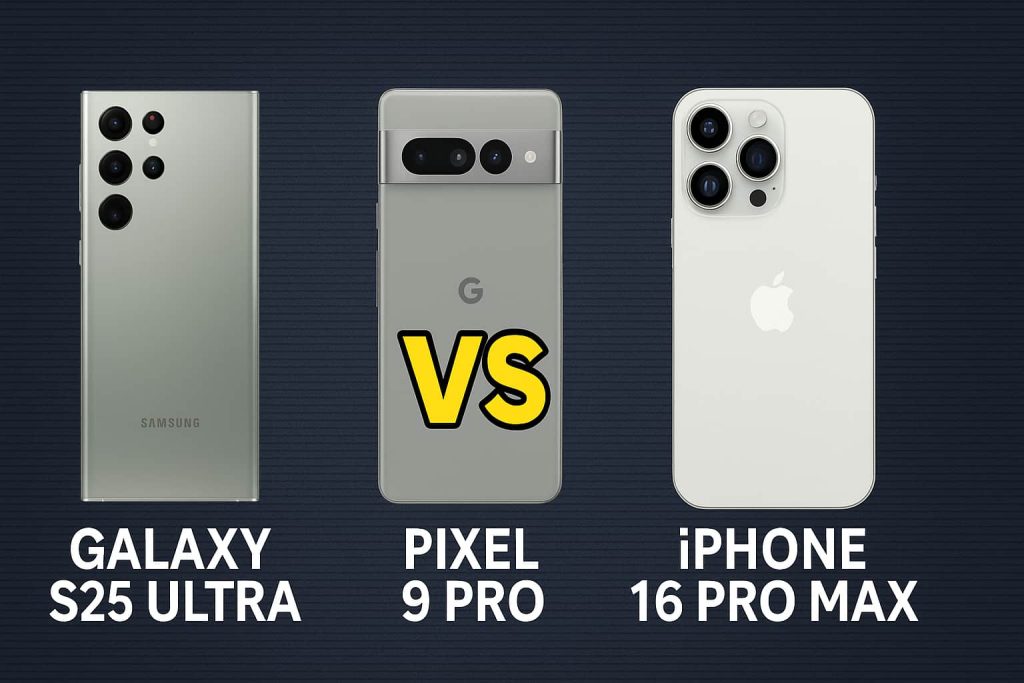The Battle of the Titans
2025 is an exciting year for tech lovers and smartphone enthusiasts. With the release of three powerhouse flagships — the Samsung Galaxy S25 Ultra, Google Pixel 9 Pro, and iPhone 16 Pro Max — the competition for the title of “best smartphone in the world” has never been tougher.
Each of these smartphones represents the very best of what their respective companies can offer. They’re not just devices — they’re ecosystems, status symbols, and performance monsters wrapped in premium materials.
But the real question is: Which one is actually worth your money in 2025?
In this ultimate comparison, we’ll break down everything — from design and display to cameras, performance, battery, software, AI integration, pricing, and even long-term value. Whether you’re an Android power user, a die-hard Apple fan, or somewhere in between — this blog will help you decide which phone truly leads the pack.
1. Design and Build Quality
Let’s face it: when spending over $1000 on a phone, aesthetics and feel matter just as much as performance.
Samsung Galaxy S25 Ultra
Samsung’s S25 Ultra features an armor-aluminum frame, curved glass back, and even slimmer bezels. It’s slightly more angular this year, giving off a bold, ultra-premium look. The iconic S Pen is still housed inside, making it the only mainstream phone offering a built-in stylus.
- Weight: ~233g
- Material: Gorilla Armor Victus 3 + Titanium edges
- Colors: Phantom Black, Titanium Gray, Ice Blue
Google Pixel 9 Pro
Google has gone more compact with the Pixel 9 Pro design, with a rounded frame and a refined rear visor for the cameras. It feels great in hand and is arguably the most comfortable of the three. Its minimalist aesthetic appeals to purists.
- Weight: ~210g
- Material: Polished aluminum + Gorilla Glass
- Colors: Obsidian, Porcelain, Bay
iPhone 16 Pro Max
Apple introduces titanium edges again this year with slightly reduced weight. The button layout remains unchanged, but the Action Button is more customizable. Apple still nails the premium, industrial design aesthetic.
- Weight: ~221g
- Material: Titanium + Ceramic Shield
- Colors: Natural Titanium, Blue, White, Black
Winner: Subjective
- Galaxy S25 Ultra = Best for stylus and bold design lovers
- Pixel 9 Pro = Best for minimalism and light feel
- iPhone 16 Pro Max = Best for timeless elegance and build
2. Display Quality
All three phones push the limits when it comes to display brilliance.
Samsung Galaxy S25 Ultra
- Size: 6.8″ Dynamic AMOLED 2X
- Resolution: QHD+ (3200×1440)
- Refresh Rate: 1–144Hz LTPO
- Peak Brightness: 3000 nits
- Special: S Pen support, Vision Booster tech
Samsung remains the king of smartphone displays. The colors are punchy, the brightness is unmatched, and the fluidity is dreamy.
Google Pixel 9 Pro
- Size: 6.7″ OLED LTPO
- Resolution: 3120×1440
- Refresh Rate: 1–120Hz
- Peak Brightness: 2600 nits
The Pixel 9 Pro screen is crisp and color-accurate, especially for content creators. Google’s display tuning is subtle, more natural-looking than Samsung’s.
iPhone 16 Pro Max
- Size: 6.7″ Super Retina XDR OLED
- Resolution: 2796×1290
- Refresh Rate: 1–120Hz ProMotion
- Peak Brightness: 2800 nits
Apple’s panel may be the least pixel-dense, but the color calibration and HDR capabilities are phenomenal. The brightness this year is notably improved.
Winner: Samsung Galaxy S25 Ultra
3. Camera System: The Ultimate Test
The smartphone camera is often the most important deciding factor for users. So how do these phones stack up?
Samsung Galaxy S25 Ultra
- Main: 200MP (f/1.7) with OIS
- Ultra-wide: 12MP
- Telephoto 1: 50MP 5x
- Telephoto 2: 10MP 3x
- Front: 12MP
Samsung has improved low-light processing and portrait photography. The dual telephoto lenses make this a beast for zoom lovers and travel shooters.
Google Pixel 9 Pro
- Main: 50MP (f/1.7)
- Ultra-wide: 48MP
- Telephoto: 48MP 5x
- Front: 12MP
Pixel’s strength is in computational photography. The Magic Editor, AI object removal, and Real Tone processing are unmatched. Its color science is more natural than Samsung or Apple.
iPhone 16 Pro Max
- Main: 48MP (f/1.8)
- Ultra-wide: 12MP
- Telephoto: 12MP 5x periscope
- Front: 12MP
Apple brings strong video capabilities — best-in-class cinematic mode, ProRes recording, and now AI-powered scene detection. Still photos are sharper with better dynamic range than before.
Winner:
- Photos: Pixel 9 Pro
- Zoom: Galaxy S25 Ultra
- Videos: iPhone 16 Pro Max

4. Performance & Processor
Samsung Galaxy S25 Ultra
- Chipset: Snapdragon 8 Gen 4 (for all models globally)
- RAM: 12GB / 16GB
- Storage: 256GB to 1TB
This is Qualcomm’s most advanced chip yet — built on N3E node with improved AI acceleration, CPU power, and GPU efficiency.
Google Pixel 9 Pro
- Chipset: Google Tensor G4
- RAM: 12GB
- Storage: 128GB to 1TB
Tensor G4 is more efficient than G3 and brings faster AI on-device, but it still lags slightly behind Snapdragon 8 Gen 4 in raw power.
iPhone 16 Pro Max
- Chipset: Apple A18 Pro (3nm)
- RAM: 8GB
- Storage: 256GB to 1TB
Apple’s custom silicon remains king in single-core performance, efficiency, and long-term support.
Winner:
- Raw Power: iPhone 16 Pro Max
- AI Tasks: Pixel 9 Pro
- Balanced Performance: Galaxy S25 Ultra
5. Battery Life & Charging
Samsung Galaxy S25 Ultra
- Battery: 5100mAh
- Charging: 65W wired, 45W wireless, reverse wireless
Samsung improved efficiency, and this phone easily lasts 1.5 days on a single charge.
Google Pixel 9 Pro
- Battery: 5050mAh
- Charging: 45W wired, 30W wireless
Good battery optimization, though Tensor still isn’t as energy-efficient as Snapdragon or A-series chips.
iPhone 16 Pro Max
- Battery: ~4600mAh
- Charging: 35W wired, 15W MagSafe
Apple’s strength is in its power management. Despite the smaller battery, it matches or exceeds Android rivals due to chip efficiency.
Winner: Samsung Galaxy S25 Ultra
6. Software Experience
Samsung Galaxy S25 Ultra
- OS: One UI 7 (based on Android 15)
- Special: DeX mode, S Pen tools, multitasking
Samsung’s One UI is feature-rich, though not as lightweight as Pixel’s UI. Software updates are now promised for 7 years.
Google Pixel 9 Pro
- OS: Android 15 (Stock)
- Special: AI features (Circle to Search, Magic Editor), quick updates
This is Android how Google envisions it — clean, fast, bloat-free. First in line for updates.
iPhone 16 Pro Max
- OS: iOS 18
- Special: AI integration in Siri, generative wallpapers, RCS support
Apple’s ecosystem is unmatched. With iOS 18, it finally opens the door to more customization and smarter on-device intelligence.
Winner: Subjective
- For customization and productivity: Samsung
- For simplicity and AI: Google
- For seamless integration: Apple
7. Price & Value
| Phone | Starting Price (USD) | Max Storage Price | Years of Support |
|---|---|---|---|
| Galaxy S25 Ultra | $1,299 | ~$1,699 | 7 Years |
| Pixel 9 Pro | $999 | ~$1,399 | 7 Years |
| iPhone 16 Pro Max | $1,199 | ~$1,699 | 6–7 Years |
Best Value: Pixel 9 Pro
If you’re budget-conscious but still want top-tier performance and camera quality, Pixel 9 Pro is the clear winner.
Final Verdict: Which Should You Buy in 2025?
Choosing between the Galaxy S25 Ultra, Pixel 9 Pro, and iPhone 16 Pro Max comes down to your priorities and ecosystem preference.
✅ Buy the Samsung Galaxy S25 Ultra if you want:
- The best display and zoom camera
- S Pen productivity
- A powerful, customizable Android experience
✅ Buy the Google Pixel 9 Pro if you want:
- The best AI camera system
- Clean, bloat-free Android
- Exceptional value for money
✅ Buy the iPhone 16 Pro Max if you want:
- The best video recording
- Deep ecosystem integration (Mac, Watch, iCloud)
- Long-term software support and resale value
Our Choice:
In 2025, there is no bad choice among these flagships. They are all incredible — yet uniquely tailored to different types of users. Whether you prioritize productivity, camera perfection, or ecosystem integration, one of these phones is bound to be your perfect match.
Whatever your choice, you’re getting the pinnacle of smartphone technology in 2025.


